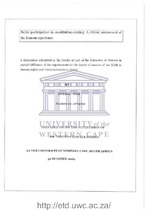| dc.description.abstract | Kenya has embarked on a constitutional making process that is hoped to ensure a transition to
democracy. The current constitution making process is not the first of its kind in post
independence Kenya.1 Since the Lancaster House Conference2 that gave Kenya its very first
constitution after independence, constitution making processes have been fraught with
controversies.3 The periods after independence saw the Kenyans glamour for constitutional
change and reforms.4 A number of amendments have been effected to the Kenyan, constitution
since independence. The clamor for constitutional review gradually grew leading to the repeal of
section 2A of the Constitution in 1991 which restored multi-parties.s The pressure from civil
society organizations in 1997 led to the enactment of the Constitution of Kenya Review
Commission Act6 and this was considered as the formal beginning of the Constitutional Review
Process in Kenya.7 The next major constitutional review process came in after the end of the
term of President Daniel Arap Moi in 2002. A review process, commonly known as the | en_US |

